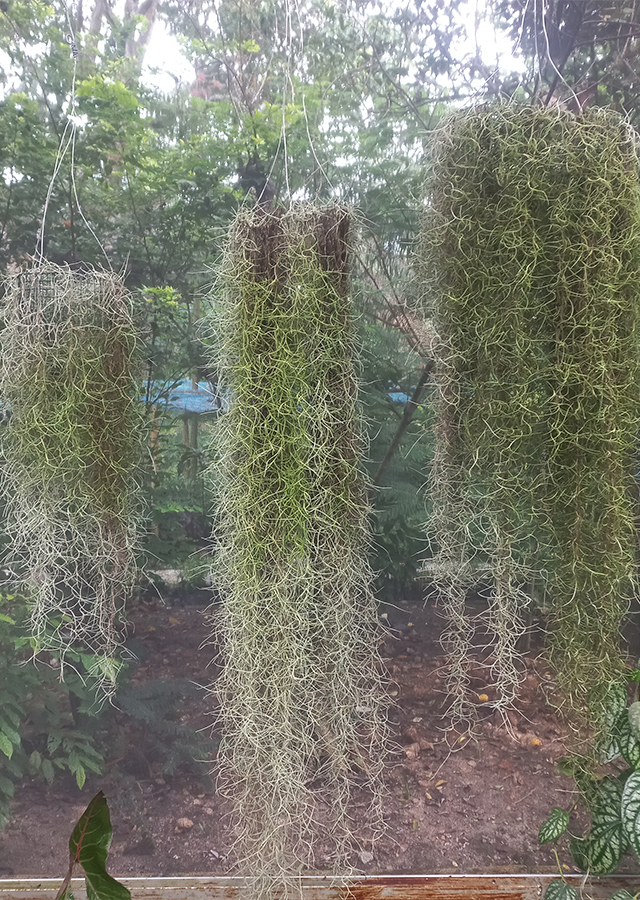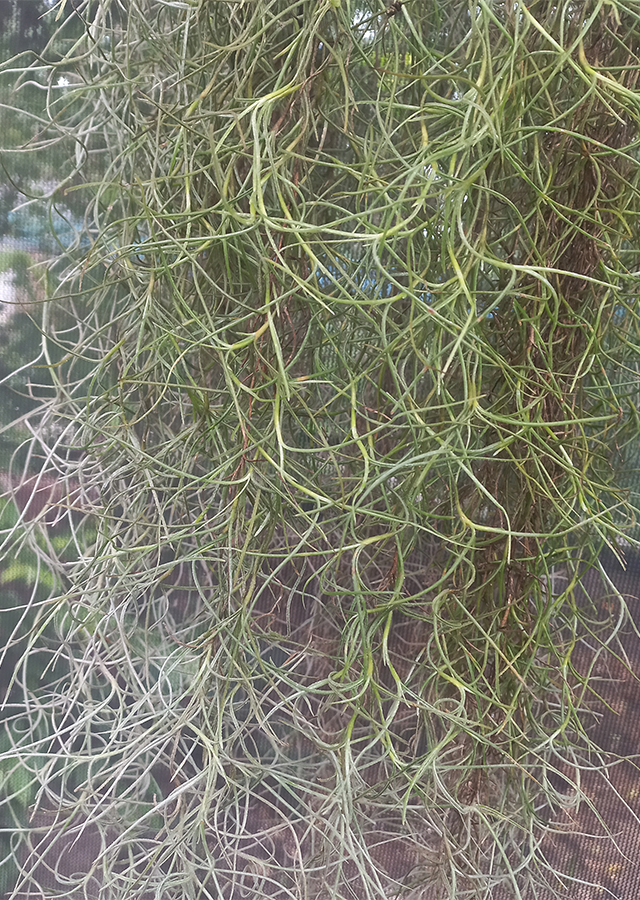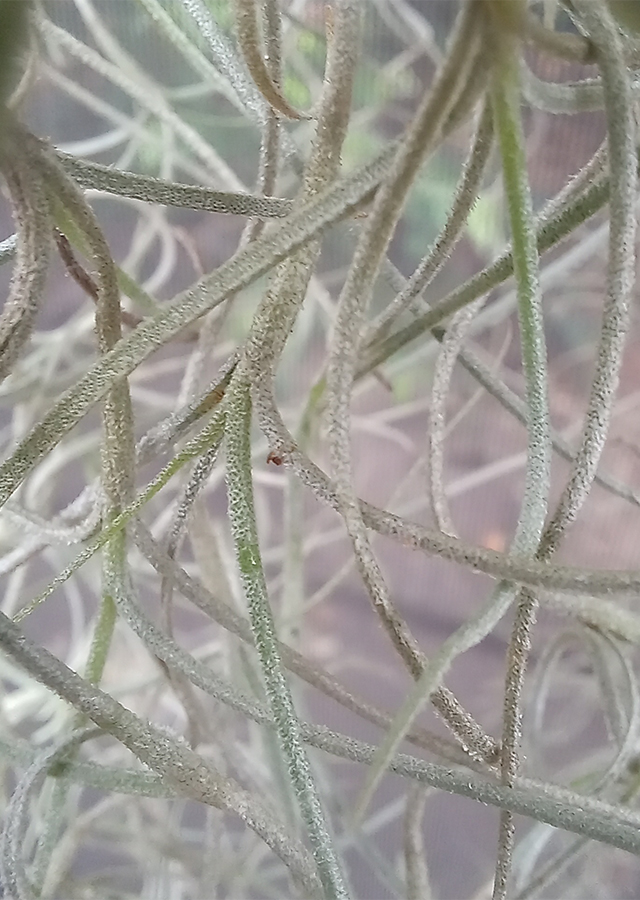Traditional Herbs from Tillandsia usneoides
rheumatism
- Prepare enough musa beard plants, wash them thoroughly.
- Boil until boiling.
- Let it warm.
- Use it to soak in the bath.
make_hair_shiny
- Prepare the plant wash enough musa's beard until it is clean.
- Soak it in a pot of water until it breaks down.
- Use it as a hair wash to give shine to your hair.
What is Tillandsia usneoides Looks like??



Parts of Tillandsia usneoides that could be used
- All Parts of the Plant
Tillandsia usneoides Distribution
Tillandsia usneoides is a plant native to most of Mexico, Bermuda, the Bahamas, Central America, South America, Southern United States, West Indies. This species has become naturalized in Queensland, Australia. Tillandsia usneoides is often grown as an ornamental plant in tropical areas, and is also used as packaging and filling material, indicator plant, mulch, decorative handicraft and craft material, source of elastic fiber, plaster or insulation material interior of the house (dry plants), food supplements and herbal medicine. Research has shown that Tillandsia usneoides accumulates mercury and is an indicator plant for detecting metal pollutants or the presence of mercury in the atmosphere. Based on its function as a packing and filling material, this species has long been used to fill mattresses, pillows, and car seats in the US and Europe, among other items. This species also produces strong elastic fibers that can be woven into mats, ropes, and sacks. Tillandsia usneoides also has a long history and therapeutic potential. This species is believed to be and is used traditionally as a herbal medicine to treat various disease complaints.Agroecology of Tillandsia usneoides
Tillandsia usneoides or Moses' beard can usually be found growing in many types of subtropical and tropical habitats. It is usually found hanging from tree branches, especially oaks and firs. This species prefers moist conditions and partial shade and also likes warm climates with high humidity. The moss beard plant absorbs most of its moisture and nutrients from the moist air around it, through the layer of absorbent scales that cover the leaves, so it does not need soil to grow.
Morphology of Tillandsia usneoides
- No roots.
- Stems are thin and elongated like threads.
- Leaves are simple, unifoliate, scattered, thin, short (length 1.5 - 3 cm, width 0.1 - 0.2 cm) found in small, twisted, narrow-linear clusters, densely covered with short silver to gray hairs known as trichomes. The hairs help absorb moisture and nutrients from the air. The leaves are silver to gray when dry, but light green when wet . Leaf edges are flat, leaf tips are pointed (acute), the base of the leaf is truncated.
- The flowers are small, pale green or blue and most fragrant at night, the flowers appear solitary in the leaf axils. In cultivation, they rarely produce flowers.
Cultivation of Tillandsia usneoides
- Plant propagation through division and stem cuttings (breaking the stem and replanting it).
- Includes plants that are easy to grow. Just hang the plant in partial shade and mist it regularly with warm water.
Tillandsia usneoides, more details :
Chemical Content of Tillandsia usneoidesTriterpenoid cycloartane, cycloarterenol, 4,5-dihydroxy-3',7-demthoxyflavanone, mixed steroids stigmasterol, ß-sitosterol, campesterol, 26 cycloartane derivatives ((22E)-25,26,27-trisnor-3-oxocycloart-22- en-24-al, (24E)-3-oxocycloart-24-en-26-al, 24-hydroxycycloart-25-en-3-one, (23E)-25-methoxycycloart-23-en-3-one, (23E)-25- hydroperoxycycloart-23-en-3-one, 25,26,27-trisnor-24-hydroxycycloartan-3-one, methyl (24E)-26-carboxy-3,4-seco-cycloart-4(29),24-dien-3-oate, methyl (23E)-25-hydroxy-3,4-seco-cycloart-23-en- 3-oate, methyl (23E)-25-methoxy-3,4-seco-cycloart-23-en-3-oate, and methyl 24-hydroxy-3,4-seco-cycloart-25-en-3-oate), carotenoids, tocotrienols, flavonoids, alkaloids, polycarpol 3-hydroxy-methylglutaric acid (HMG).
Benefits of Tillandsia usneoides
Treating diabetes mellitus, rheumatism, open wounds, hemorrhoids, coughs, asthma, bronchitis, boils, reducing fever, gallbladder problems, lung disease, liver, kidney, heart, overcoming sexual weakness, coldness, indigestion due to overeating, speeding up childbirth, natural contraception, strengthens and makes hair shinier and more attractive, eliminates dandruff. Has activity as an antioxidant, antiepileptic, astringent, antipyretic and analgesic.
Simplisia of Tillandsia usneoides
- Prepare enough musa beard plants, wash them thoroughly with running water.
- Dry in the sun or in an oven at a temperature\u00a040\u00b0C until the moisture content\u00a010%.
- Store in a clean and airtight container." ]
Another Facts for Tillandsia usneoides :
Synonym of Tillandsia usneoides
Dendropogon usneoides (L.) Raf., Tillandsia crinita Willd. ex Beer, Tillandsia trichoides Kunth
Habitus of Tillandsia usneoides
Herb. Hanging, annual epiphyte, growing to 6 m or more in length
Habitat of Tillandsia usneoides
- Riverside
- Forest
No comments:
Post a Comment